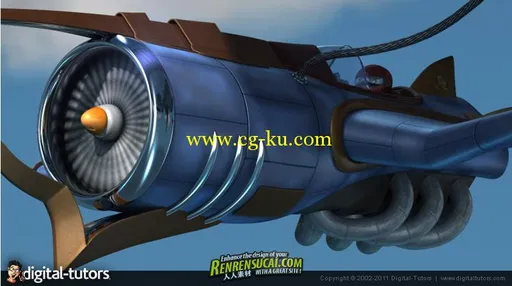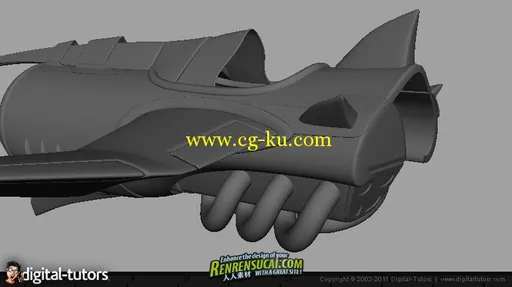由Digital Tutors公司最新出品的Digital Tutors Introduction to Maya 2012 教程,Maya 2012全面深入学习教程。2011年8月释放。教程内容包括建模,建模部分完成后你将有机会尝试纹理,索具,动画,动力学,最后的照明和渲染自己的动画。
教程所使用的软件:Maya 2012 and up
在Maya 2012中大幅提高了viewport视窗的功能,最强大之处在于直接支持运动模糊(motion blur)的显示。景深通道(depth-of-field)和环境隔绝(occlusion)效果也可以直接在视窗中显示出来。新的运动轨迹(Motion Trails)编辑功能可以让你无需打开图形编辑器动画路径。Maya2012内置了基于NVIDIA显卡技术的的PhysX引擎,还有一个名叫"Digital Molecular Matter"的插件来制作高级破碎特效。新的流体功能也可以用来模拟流体的沸腾、浇注和飞溅效果。
Maya 是目前世界上最为优秀的三维动画的制作软件之一,主要是为了影视应用而研发的,所以在出世后不久就在《精灵鼠小弟》、《恐龙》等这些大片中一展身手。除了影视方面的应用外Maya在三维动画制作,影视广告设计,多媒体制作甚至游戏制作领域都有很出色的表现。初识Maya 是目前世界上最为优秀的三维动画的制作软件之一,它是Alias|Wavefront公司在1998年才推出的三维制作软件。虽然相对于其他老牌三维制作软件来说Maya还是一个新生儿,但Maya凭借其强大的功能,友好的用户界面和丰富的视觉效果,一经推出就引起了动画和影视界的广泛关注,成为顶级的三维动画制作软件。
In this series of lessons, we will help you get a strong understanding of Maya and how it works. You'll get the chance to work with many of the Maya instructors here at Digital-Tutors who will show you how to use some of the major components of Maya.
In this course, we'll start by giving you the foundational skills and vocabulary you'll need in order to move around within Maya, and then we'll jump right into the Modeling section of the course. After completing the Modeling section, you'll get the chance try your hand at Texturing, Rigging, Animation, Dynamics, and finally, Lighting and Rendering your own animation. Our goal is not to weigh you down with technical information, but rather to help you form good habits and strong workflows so you can become a proficient Maya artist.
教程内容如下:
1. Introduction and project overview 2
2. Camera navigation and object creation in Maya
3. Maya interface overview
4. Creating your first Maya project
5. Saving Maya files
6. Viewport shading modes in Maya
7. Object transformation tools
8. Working with the Channel Box and Layer Editor
9. Using the Attribute Editor
10. Grouping and parenting objects in Maya
11. Working with the Maya Hotbox
12. Selection Masks in Maya
13. Writing your first MEL script
14. Working with shelves in Maya
15. Modeling Section Overview
16. Lofting the fuselage with curves
17. Trimming out part of the body
18. Creating the sides of the cockpit
19. Building the wing base
20. Converting the wing to polygons
21. Cutting flaps from the wing
22. Building the rear engine block
23. Adding curved pipes to the engine
24. Starting the turbo fan
25. Building the fan blades
26. Starting the front spine piece
27. Adding detail to finish the spine
28. Duplicating geometry to add overlapping pieces
29. Adding secondary details on the fuselage
30. Building panels from converted geometry
31. Extracting curves to build the windscreen
32. Building the fins from primitive geometry
33. Modeling the interior of the cockpit
34. Adding the exhaust ports
35. Modeling final details
36. Importing geometry and adding the fuel line
37. Materials and Texturing Overview
38. Working with the Hypershade
39. Applying and manipulating simple materials
40. Using ramps
41. Adding multiple materials to objects
42. Working with transparency
43. The basics of UVs
44. Working with procedural textures
45. Combining procedural nodes
46. Adding specialized materials
47. Using external file textures
48. Working with Substance textures
49. Rigging Section Overview
50. Creating control curves
51. Using display layers to organize our rig
52. Modifying an object's orientation and pivot
53. Utilizing selection handles
54. Working with Clusters
55. Creating custom attributes
56. Using the Connection Editor to drive attributes
57. Using Set Driven Keys to simplify the rigging process
58. Automating movement with expressions
59. Adding a speed setting for the expression
60. Drawing your first joint chain
61. Using Maya's IK Handle
62. Binding geometry to joints
63. Making your scene animator-friendly
64. Animation Section Overview
65. Learning to keyframe and modify keys on the Time Slider 8
66. Managing keyframes in the Graph Editor
67. Seamlessly cycling animation
68. Animating an object along a path
69. Modifying how an object interpolates along a path
70. Working with Autokey
71. Correcting animation with Editable Motion Trails
72. Previewing animation in real-time with playblasts
73. Dynamics section overview
74. Creating a dynamic fire effect
75. Creating a particle emitter
76. Connecting emitters to objects
77. Creating per-particle attributes
78. Using the Particle Volume Shader
79. Lighting and Rendering section overview
80. Working with the Maya Render View
81. Controlling anti-aliasing quality of your renders
82. Understanding Clipping Planes and Resolution Gates
83. Understanding the various light types in Maya
84. Common light attributes
85. Adding shadows to your renders
86. Changing the Render Stats of objects
87. Matching lights to a photographic environment
88. Using the Attribute Spread Sheet
89. Adding motion blur to your renders
90. Rendering an animated sequence from Maya
【115



发布日期: 2011-8-13